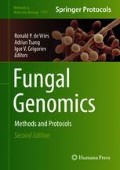Abstract
In the present chapter, we present the protocols and guidelines to facilitate implementation of CRISPR-Cas9 technology in fungi where few or no genetic tools are in place. Hence, we firstly explain how to identify dominant markers for genetic transformation. Secondly, we provide a guide for construction of Cas9/sgRNA episomal expression vectors. Thirdly, we present how to mutagenize reporter genes to explore the efficiency of CRISPR-Cas9 in the relevant fungus and to ease subsequent CRISPR-mediated genetic engineering. Lastly, we describe how to make CRISPR-mediated marker-dependent and marker-free gene targeting.
Access this chapter
Tax calculation will be finalised at checkout
Purchases are for personal use only
References
Krappmann S (2007) Gene targeting in filamentous fungi: the benefits of impaired repair. Fungal Biol Rev 21:25–29. https://doi.org/10.1016/j.fbr.2007.02.004
Doudna JA, Charpentier E (2014) The new frontier of genome engineering with CRISPR-Cas9. Science 346:1258096. https://doi.org/10.1126/science.1258096
Sander JD, Joung JK (2014) CRISPR-Cas systems for editing, regulating and targeting genomes. Nat Biotechnol 32:347–355. https://doi.org/10.1038/nbt.2842
Jinek M, Chylinski K, Fonfara I, Hauer M, Doudna JA, Charpentier E (2012) A programmable dual-RNA-guided DNA endonuclease in adaptive bacterial immunity. Science 337:816–821. https://doi.org/10.1126/science.1225829
Nødvig CS, Nielsen JB, Kogle ME, Mortensen UH (2015) A CRISPR-Cas9 system for genetic engineering of filamentous fungi. PLoS One 10:e0133085. https://doi.org/10.1371/journal.pone.0133085
Weber J, Valiante V, Nødvig CS, Mattern DJ, Slotkowski R, Mortensen UH, Brakhage AA (2017) Functional reconstitution of a fungal natural product gene cluster by advanced genome editing. ACS Synth Biol 20:62–68. https://doi.org/10.1021/acssynbio.6b00203
Wenderoth M, Pinecker C, Voß B, Fischer R (2017) Establishment of CRISPR/Cas9 in Alternaria alternata. Fungal Genet Biol 101:55–60
Nielsen ML, Isbrandt T, Rasmussen KB, Thrane U, Hoof JB, TO L, Mortensen UH (2017) Genes linked to production of secondary metabolites in Talaromyces atroroseus revealed using CRISPR-Cas9. PLoS One 12:e0169712
Kalderon D, Roberts BL, Richardson WD, Smith AE (1984) A short amino acid sequence able to specify nuclear location. Cell 39:499–509
Lanford RE, Butel JS (1984) Construction and characterization of an SV40 mutant defective in nuclear transport of T antigen. Cell 37:801–813
Gao Y, Zhao Y (2014) Self-processing of ribozyme-flanked RNAs into guide RNAs in vitro and in vivo for CRISPR-mediated genome editing. J Integr Plant Biol 56:343–349
Gems D, Johnstone IL, Clutterbuck AJ (1991) An autonomously replicating plasmid transforms Aspergillus nidulans at high frequency. Gene 98:61–67
Nour-Eldin HH, Geu-Flores F, Halkier BA (2010) USER cloning and USER fusion: the ideal cloning techniques for small and big laboratories. Methods Mol Biol 643:185–200
Nørholm MHH (2010) A mutant Pfu DNA polymerase designed for advanced uracil-excision DNA engineering. BMC Biotechnol 10:21
Alani E, Cao L, Kleckner N (1987) A method for gene disruption that allows repeated use of URA3 selection in the construction of multiply disrupted yeast strains. Genetics 116:541–545
d’Enfert C (1996) Selection of multiple disruption events in Aspergillus fumigatus using the orotidine-5′-decarboxylase gene, pyrG, as a unique transformation marker. Curr Genet 30:76. https://doi.org/10.1007/s002940050103
Liu R, Chen L, Jiang Y, Zhou Z, Zou G (2015) Efficient genome editing in filamentous fungus Trichoderma reesei using the CRISPR/Cas9 system. Cell Discov 1:15007. https://doi.org/10.1038/celldisc.2015.7
Gibson DG, Young L, Chuang R, Venter JC, Hutchison CA III, Smith HO (2009) Enzymatic assembly of DNA molecules up to several hundred kilobases. Nat Methods 6:343–345
Li MZ, Elledge SJ (2012) SLIC: a method for sequence- and ligation-independent cloning. Methods Mol Biol 852:51–59
Zhang Y, Werling U, Edelmann W (2012) SLiCE: a novel bacterial cell extract-based DNA cloning method. Nucleic Acids Res 40:1–10
Rothstein RJ (1983) One-step gene disruption in yeast. Methods Enzymol 101:202–211
Author information
Authors and Affiliations
Corresponding author
Editor information
Editors and Affiliations
Rights and permissions
Copyright information
© 2018 Springer Science+Business Media, LLC, part of Springer Nature
About this protocol
Cite this protocol
Hoof, J.B., Nødvig, C.S., Mortensen, U.H. (2018). Genome Editing: CRISPR-Cas9. In: de Vries, R., Tsang, A., Grigoriev, I. (eds) Fungal Genomics. Methods in Molecular Biology, vol 1775. Humana Press, New York, NY. https://doi.org/10.1007/978-1-4939-7804-5_11
Download citation
DOI: https://doi.org/10.1007/978-1-4939-7804-5_11
Published:
Publisher Name: Humana Press, New York, NY
Print ISBN: 978-1-4939-7803-8
Online ISBN: 978-1-4939-7804-5
eBook Packages: Springer Protocols

